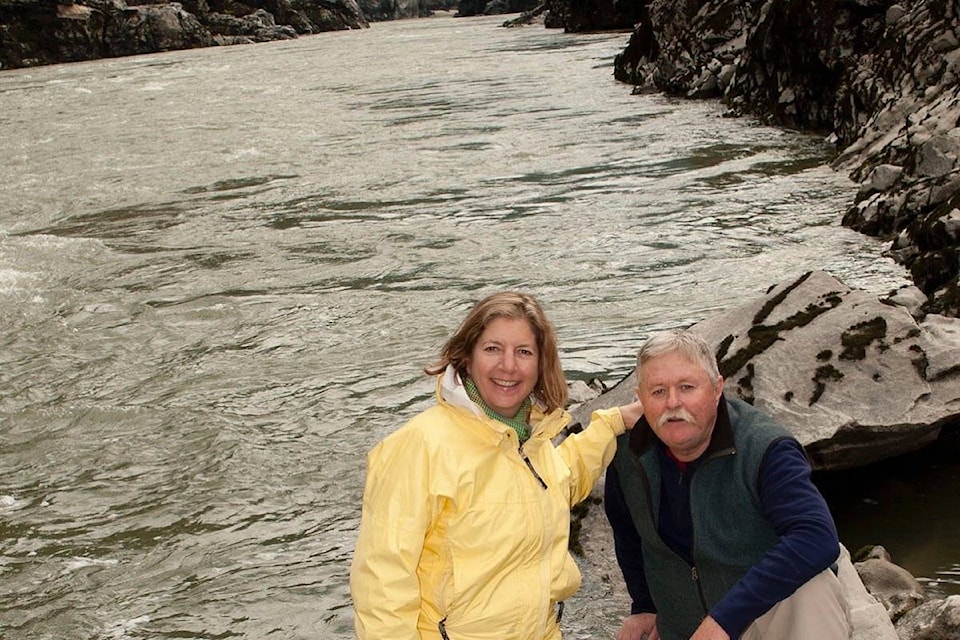While other people get diamonds for their 10th wedding anniversary, Carol Blacklaws got covered in silt from her first time rafting down the Fraser River.
Thirty years later, she and her husband Rick remain enthralled with the Fraser — the 11th largest river in Canada — and are hoping to raise the profile of its rugged and wild beauty through their new coffee-table book, The Fraser: River of Life and Legend.
Part memoir and part photographic journal, the tale — told through Carol’s eyes and Rick’s photographs — brings to vivid life the world along the banks of the 1,375-kilometre mighty river.
“We view the river as being a very beautiful place that has hidden gems that are accessible to us here in B.C.,” Carol says. “We enjoy going on the river, and we have an affiliation to the river that we want to share.”
The book begins in the river’s Upper Reaches at Moose Lake — the only lake on the Fraser — and the glacial waters at Mt. Robson before flowing in a “sediment-rich slurry” toward the Pacific Ocean. The Blackwells’ journey, captured over 20 years of exploration, shares the intimate history, both past and present, on the river’s shores as it wends its way through the Cariboo, the Grasslands, and the Fraser Canyon to the salty waters of the Strait of Georgia.
The Blackwells, whose son became a river guide and named his own son Fraser, want to raise the profile of the Fraser, recognizing it for the rich resource that it is. While lakes and oceans are touted as tourist draws, much of the Fraser is only accessible by backroads or river rafts. There are few campsites and little accessibility except to those who work on it.
Locals know their sections of the river, Rick says, but “the river isn’t that accessible to the average person.” He describes the Fraser as a “river of diversity like four or five countries that are joined,” each with different characteristics: the broadness of the river in the Robson Valley, the Cariboo where the river is right next to the surface, and the Grasslands, where the river drops down.
“There’s a whole different landscape. Just a fun river of great diversity. It just offers us so much, it’s like a palate,” he says. “To know a river and to be able to get on it creates a profile that will create awareness of the river.
“As a photographer, it’s a gift to me. It’s accessible. I don’t have to take a helicopter or an airplane, I can poke along and see great places.”
His favourite section as a photographer is OK Ranch to Big Bar ferry and north to the Gang Ranch, while Carol prefers the rugged and “mind-boggling” beauty of the Fraser Canyon. She believes it should be declared a heritage corridor with recreation potential. While some believe the river to be polluted, she explains that the main stem of the Fraser has no lakes, which typically act as settling ponds for the river’s clay, silt, and sand particles.
“If this river were in a denser population such as the United States it would have the profile it deserves, such as the Columbia, that has nine dams on it. Here is this beautiful resource in B.C. that goes somewhat unnoticed,” she says. “Access to the river has been consciously denied in my opinion.”
In some ways, though, she says this may have preserved the river in terms of erosion. “It may be a blessing in disguise.”
There is evidence of life on those shores. At Tete Jaune Cache, an old cabin bears the names of the Japanese men interned there. A monument in the Grasslands pays homage to the North Canyon Secwepemc villages that became extinct because of the smallpox epidemic. Bighorn sheep still dominate the mountains above Big Bar Ferry. Camels wearing canvas boots once roamed the area around Lillooet before apparently breeding with sheep to create the elusive “Sidehill Gouger”.
The Blackwells want to portray the river as an iconic natural resource to be honoured. They believe that if enough people could see its worth they would protect it from the continued degradation of the river from dumping, the destruction of the natural shoreline with development, and the building of bridges across it.
Carol would love to promote a different perspective of the river for the people who cross it daily on their commute and see it as a traffic snarl, and who may not be aware of “the incredibly diverse waterway and the heritage they are crossing every day. I was hoping the traffic report would start to name the river rather than the tunnel or the bridge. It’s a legacy to have that river.”
editorial@accjournal.ca
Like us on Facebook and follow us on Twitter
